Jinwoo Shin
Korea Advanced Institute of Science and Technology
Meta-Learning with Self-Improving Momentum Target
Oct 11, 2022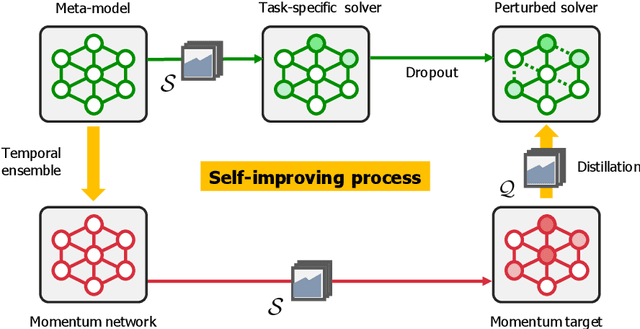
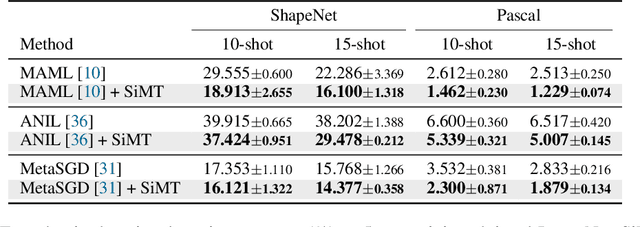
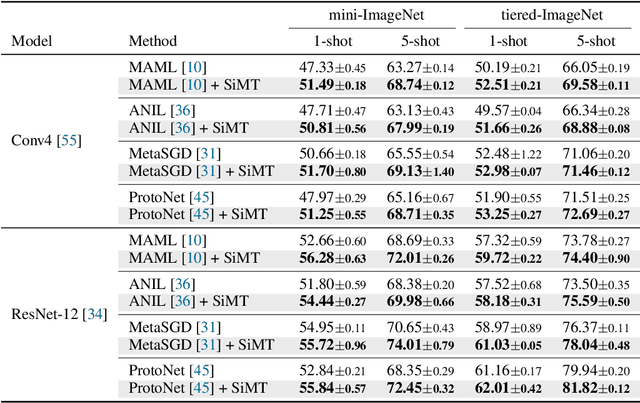
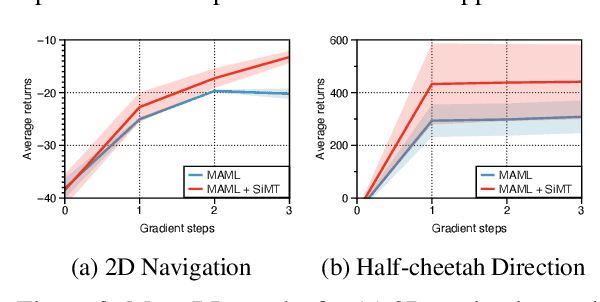
Abstract:The idea of using a separately trained target model (or teacher) to improve the performance of the student model has been increasingly popular in various machine learning domains, and meta-learning is no exception; a recent discovery shows that utilizing task-wise target models can significantly boost the generalization performance. However, obtaining a target model for each task can be highly expensive, especially when the number of tasks for meta-learning is large. To tackle this issue, we propose a simple yet effective method, coined Self-improving Momentum Target (SiMT). SiMT generates the target model by adapting from the temporal ensemble of the meta-learner, i.e., the momentum network. This momentum network and its task-specific adaptations enjoy a favorable generalization performance, enabling self-improving of the meta-learner through knowledge distillation. Moreover, we found that perturbing parameters of the meta-learner, e.g., dropout, further stabilize this self-improving process by preventing fast convergence of the distillation loss during meta-training. Our experimental results demonstrate that SiMT brings a significant performance gain when combined with a wide range of meta-learning methods under various applications, including few-shot regression, few-shot classification, and meta-reinforcement learning. Code is available at https://github.com/jihoontack/SiMT.
String-based Molecule Generation via Multi-decoder VAE
Aug 23, 2022



Abstract:In this paper, we investigate the problem of string-based molecular generation via variational autoencoders (VAEs) that have served a popular generative approach for various tasks in artificial intelligence. We propose a simple, yet effective idea to improve the performance of VAE for the task. Our main idea is to maintain multiple decoders while sharing a single encoder, i.e., it is a type of ensemble techniques. Here, we first found that training each decoder independently may not be effective as the bias of the ensemble decoder increases severely under its auto-regressive inference. To maintain both small bias and variance of the ensemble model, our proposed technique is two-fold: (a) a different latent variable is sampled for each decoder (from estimated mean and variance offered by the shared encoder) to encourage diverse characteristics of decoders and (b) a collaborative loss is used during training to control the aggregated quality of decoders using different latent variables. In our experiments, the proposed VAE model particularly performs well for generating a sample from out-of-domain distribution.
RényiCL: Contrastive Representation Learning with Skew Rényi Divergence
Aug 12, 2022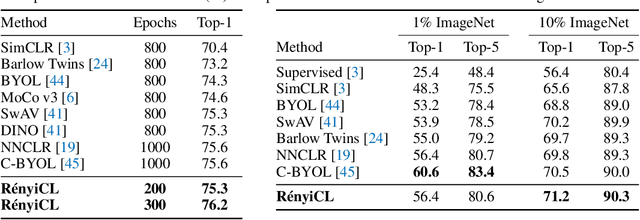
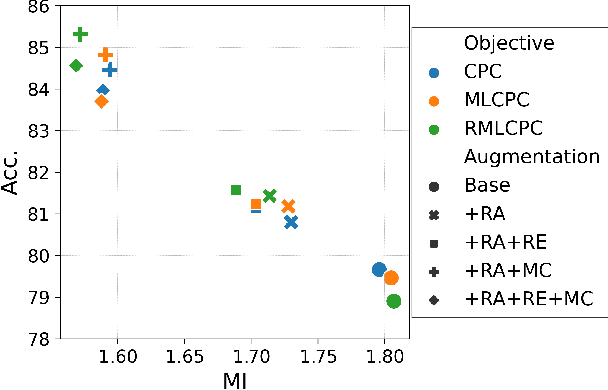
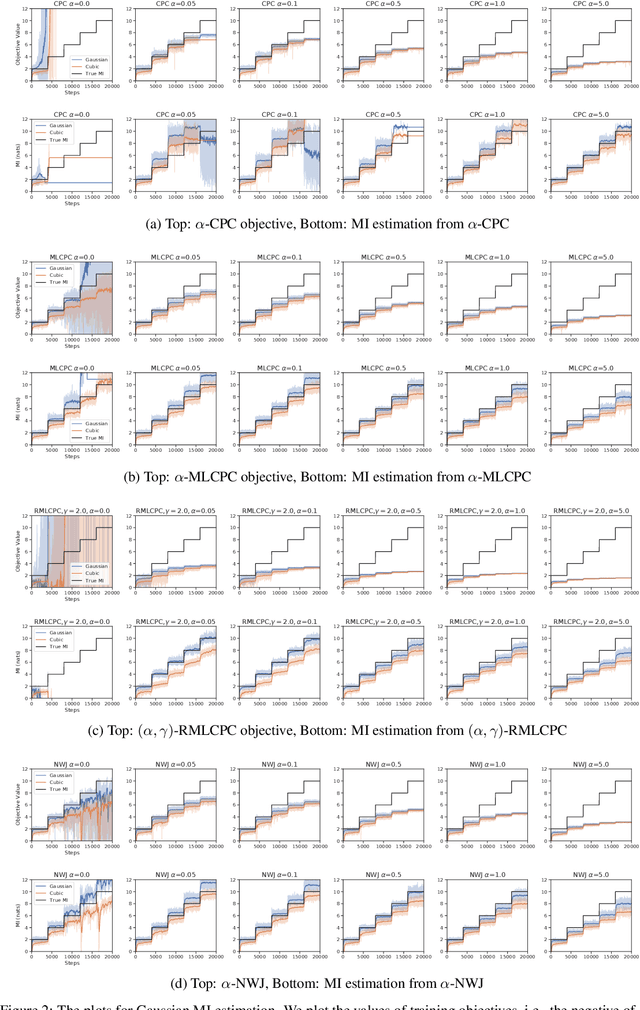

Abstract:Contrastive representation learning seeks to acquire useful representations by estimating the shared information between multiple views of data. Here, the choice of data augmentation is sensitive to the quality of learned representations: as harder the data augmentations are applied, the views share more task-relevant information, but also task-irrelevant one that can hinder the generalization capability of representation. Motivated by this, we present a new robust contrastive learning scheme, coined R\'enyiCL, which can effectively manage harder augmentations by utilizing R\'enyi divergence. Our method is built upon the variational lower bound of R\'enyi divergence, but a na\"ive usage of a variational method is impractical due to the large variance. To tackle this challenge, we propose a novel contrastive objective that conducts variational estimation of a skew R\'enyi divergence and provide a theoretical guarantee on how variational estimation of skew divergence leads to stable training. We show that R\'enyi contrastive learning objectives perform innate hard negative sampling and easy positive sampling simultaneously so that it can selectively learn useful features and ignore nuisance features. Through experiments on ImageNet, we show that R\'enyi contrastive learning with stronger augmentations outperforms other self-supervised methods without extra regularization or computational overhead. Moreover, we also validate our method on other domains such as graph and tabular, showing empirical gain over other contrastive methods.
Robust Continual Test-time Adaptation: Instance-aware BN and Prediction-balanced Memory
Aug 10, 2022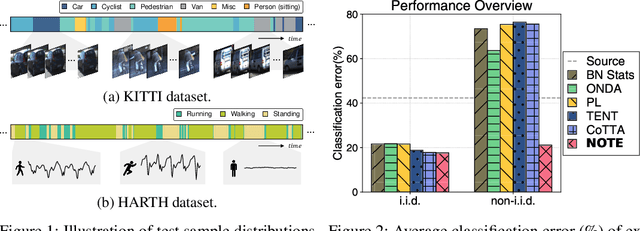
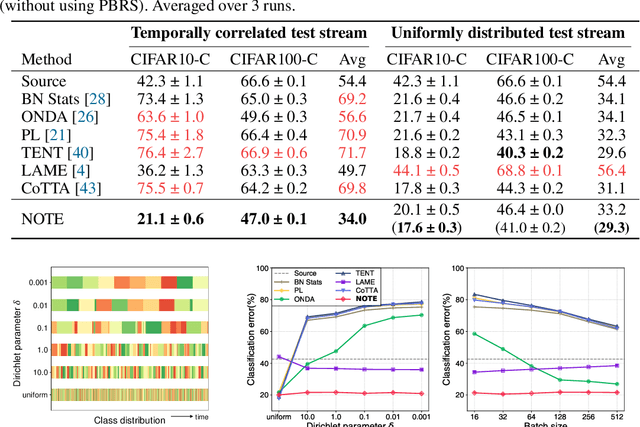
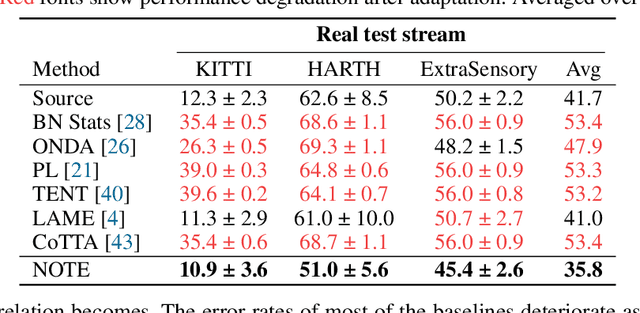

Abstract:Test-time adaptation (TTA) is an emerging paradigm that addresses distributional shifts between training and testing phases without additional data acquisition or labeling cost; only unlabeled test data streams are used for continual model adaptation. Previous TTA schemes assume that the test samples are independent and identically distributed (i.i.d.), even though they are often temporally correlated (non-i.i.d.) in application scenarios, e.g., autonomous driving. We discover that most existing TTA methods fail dramatically under such scenarios. Motivated by this, we present a new test-time adaptation scheme that is robust against non-i.i.d. test data streams. Our novelty is mainly two-fold: (a) Instance-Aware Batch Normalization (IABN) that corrects normalization for out-of-distribution samples, and (b) Prediction-balanced Reservoir Sampling (PBRS) that simulates i.i.d. data stream from non-i.i.d. stream in a class-balanced manner. Our evaluation with various datasets, including real-world non-i.i.d. streams, demonstrates that the proposed robust TTA not only outperforms state-of-the-art TTA algorithms in the non-i.i.d. setting, but also achieves comparable performance to those algorithms under the i.i.d. assumption.
Time Is MattEr: Temporal Self-supervision for Video Transformers
Jul 19, 2022

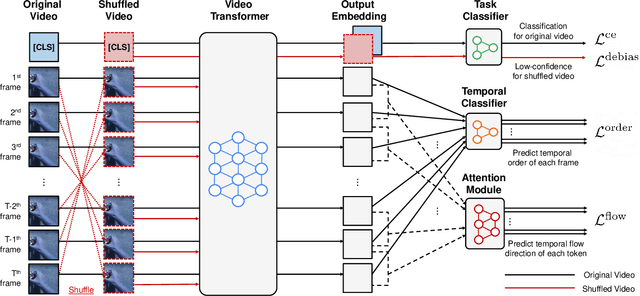
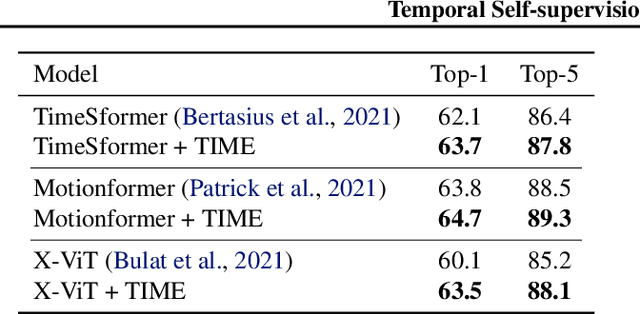
Abstract:Understanding temporal dynamics of video is an essential aspect of learning better video representations. Recently, transformer-based architectural designs have been extensively explored for video tasks due to their capability to capture long-term dependency of input sequences. However, we found that these Video Transformers are still biased to learn spatial dynamics rather than temporal ones, and debiasing the spurious correlation is critical for their performance. Based on the observations, we design simple yet effective self-supervised tasks for video models to learn temporal dynamics better. Specifically, for debiasing the spatial bias, our method learns the temporal order of video frames as extra self-supervision and enforces the randomly shuffled frames to have low-confidence outputs. Also, our method learns the temporal flow direction of video tokens among consecutive frames for enhancing the correlation toward temporal dynamics. Under various video action recognition tasks, we demonstrate the effectiveness of our method and its compatibility with state-of-the-art Video Transformers.
Patch-level Representation Learning for Self-supervised Vision Transformers
Jun 17, 2022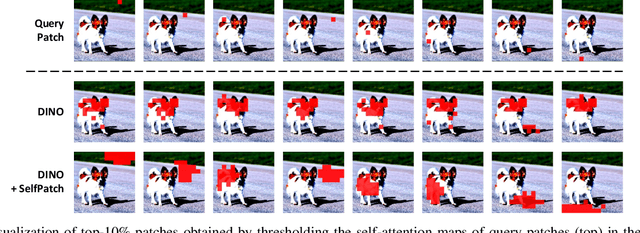
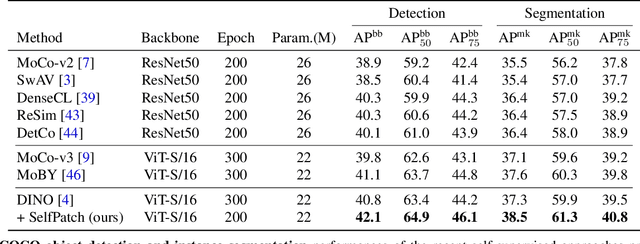
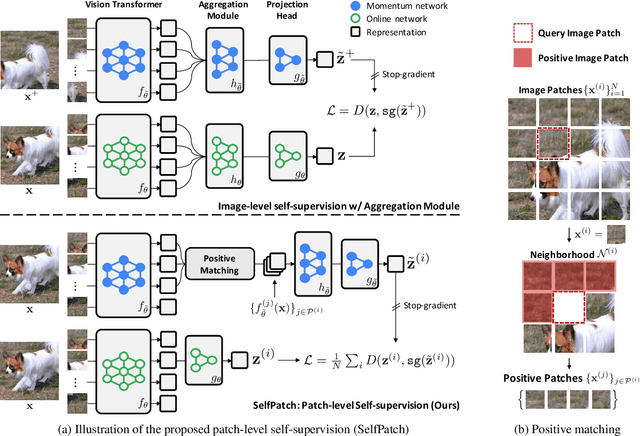
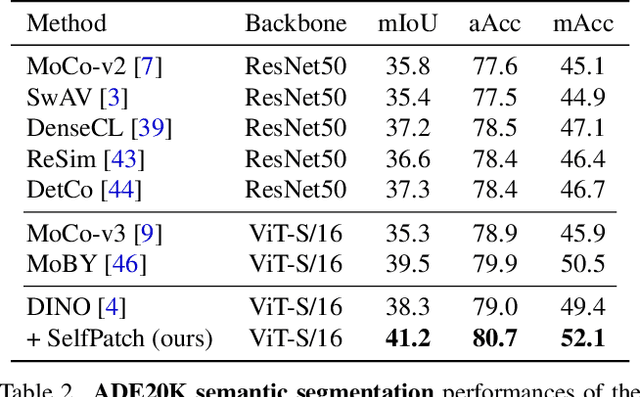
Abstract:Recent self-supervised learning (SSL) methods have shown impressive results in learning visual representations from unlabeled images. This paper aims to improve their performance further by utilizing the architectural advantages of the underlying neural network, as the current state-of-the-art visual pretext tasks for SSL do not enjoy the benefit, i.e., they are architecture-agnostic. In particular, we focus on Vision Transformers (ViTs), which have gained much attention recently as a better architectural choice, often outperforming convolutional networks for various visual tasks. The unique characteristic of ViT is that it takes a sequence of disjoint patches from an image and processes patch-level representations internally. Inspired by this, we design a simple yet effective visual pretext task, coined SelfPatch, for learning better patch-level representations. To be specific, we enforce invariance against each patch and its neighbors, i.e., each patch treats similar neighboring patches as positive samples. Consequently, training ViTs with SelfPatch learns more semantically meaningful relations among patches (without using human-annotated labels), which can be beneficial, in particular, to downstream tasks of a dense prediction type. Despite its simplicity, we demonstrate that it can significantly improve the performance of existing SSL methods for various visual tasks, including object detection and semantic segmentation. Specifically, SelfPatch significantly improves the recent self-supervised ViT, DINO, by achieving +1.3 AP on COCO object detection, +1.2 AP on COCO instance segmentation, and +2.9 mIoU on ADE20K semantic segmentation.
Zero-shot Blind Image Denoising via Implicit Neural Representations
Apr 05, 2022
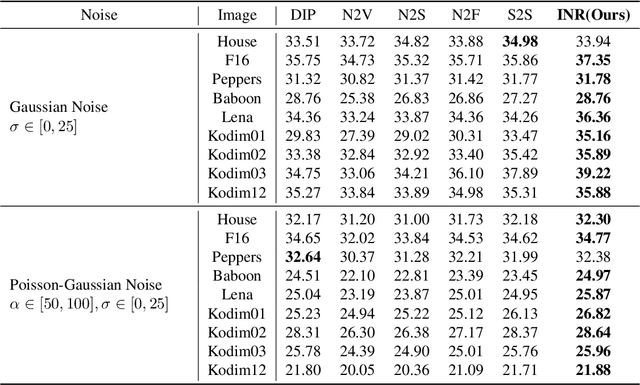
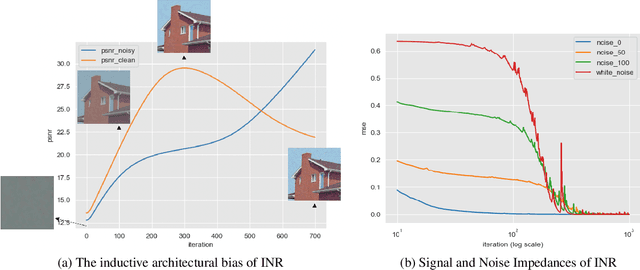

Abstract:Recent denoising algorithms based on the "blind-spot" strategy show impressive blind image denoising performances, without utilizing any external dataset. While the methods excel in recovering highly contaminated images, we observe that such algorithms are often less effective under a low-noise or real noise regime. To address this gap, we propose an alternative denoising strategy that leverages the architectural inductive bias of implicit neural representations (INRs), based on our two findings: (1) INR tends to fit the low-frequency clean image signal faster than the high-frequency noise, and (2) INR layers that are closer to the output play more critical roles in fitting higher-frequency parts. Building on these observations, we propose a denoising algorithm that maximizes the innate denoising capability of INRs by penalizing the growth of deeper layer weights. We show that our method outperforms existing zero-shot denoising methods under an extensive set of low-noise or real-noise scenarios.
Spread Spurious Attribute: Improving Worst-group Accuracy with Spurious Attribute Estimation
Apr 05, 2022



Abstract:The paradigm of worst-group loss minimization has shown its promise in avoiding to learn spurious correlations, but requires costly additional supervision on spurious attributes. To resolve this, recent works focus on developing weaker forms of supervision -- e.g., hyperparameters discovered with a small number of validation samples with spurious attribute annotation -- but none of the methods retain comparable performance to methods using full supervision on the spurious attribute. In this paper, instead of searching for weaker supervisions, we ask: Given access to a fixed number of samples with spurious attribute annotations, what is the best achievable worst-group loss if we "fully exploit" them? To this end, we propose a pseudo-attribute-based algorithm, coined Spread Spurious Attribute (SSA), for improving the worst-group accuracy. In particular, we leverage samples both with and without spurious attribute annotations to train a model to predict the spurious attribute, then use the pseudo-attribute predicted by the trained model as supervision on the spurious attribute to train a new robust model having minimal worst-group loss. Our experiments on various benchmark datasets show that our algorithm consistently outperforms the baseline methods using the same number of validation samples with spurious attribute annotations. We also demonstrate that the proposed SSA can achieve comparable performances to methods using full (100%) spurious attribute supervision, by using a much smaller number of annotated samples -- from 0.6% and up to 1.5%, depending on the dataset.
SURF: Semi-supervised Reward Learning with Data Augmentation for Feedback-efficient Preference-based Reinforcement Learning
Mar 18, 2022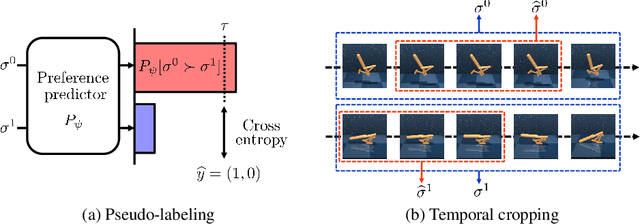

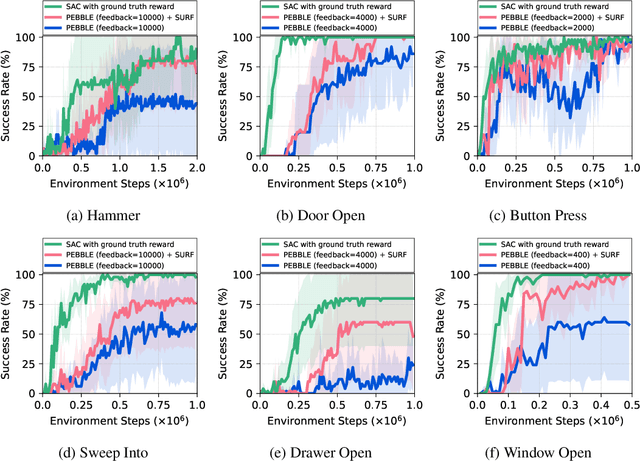

Abstract:Preference-based reinforcement learning (RL) has shown potential for teaching agents to perform the target tasks without a costly, pre-defined reward function by learning the reward with a supervisor's preference between the two agent behaviors. However, preference-based learning often requires a large amount of human feedback, making it difficult to apply this approach to various applications. This data-efficiency problem, on the other hand, has been typically addressed by using unlabeled samples or data augmentation techniques in the context of supervised learning. Motivated by the recent success of these approaches, we present SURF, a semi-supervised reward learning framework that utilizes a large amount of unlabeled samples with data augmentation. In order to leverage unlabeled samples for reward learning, we infer pseudo-labels of the unlabeled samples based on the confidence of the preference predictor. To further improve the label-efficiency of reward learning, we introduce a new data augmentation that temporally crops consecutive subsequences from the original behaviors. Our experiments demonstrate that our approach significantly improves the feedback-efficiency of the state-of-the-art preference-based method on a variety of locomotion and robotic manipulation tasks.
Generating Videos with Dynamics-aware Implicit Generative Adversarial Networks
Feb 21, 2022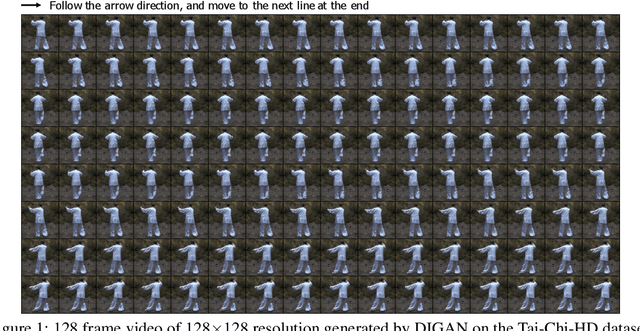
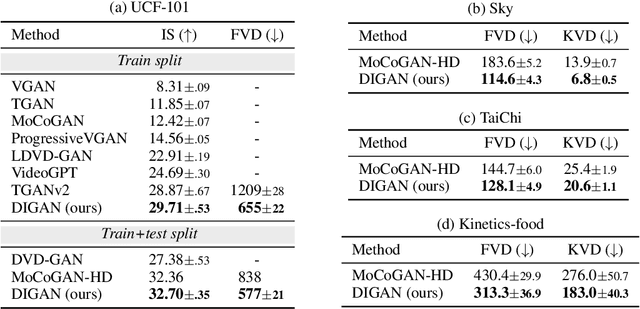
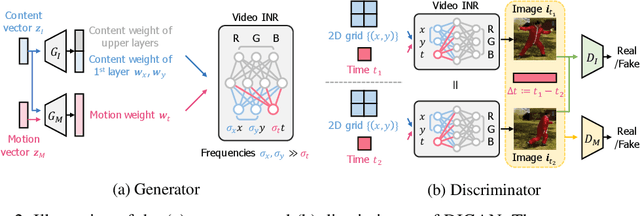
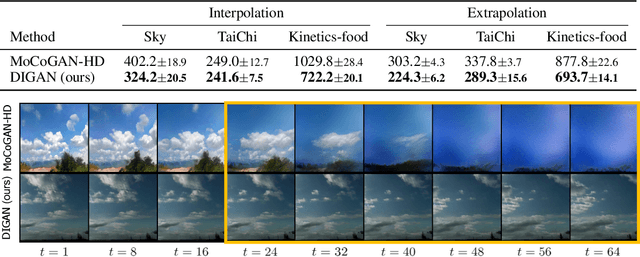
Abstract:In the deep learning era, long video generation of high-quality still remains challenging due to the spatio-temporal complexity and continuity of videos. Existing prior works have attempted to model video distribution by representing videos as 3D grids of RGB values, which impedes the scale of generated videos and neglects continuous dynamics. In this paper, we found that the recent emerging paradigm of implicit neural representations (INRs) that encodes a continuous signal into a parameterized neural network effectively mitigates the issue. By utilizing INRs of video, we propose dynamics-aware implicit generative adversarial network (DIGAN), a novel generative adversarial network for video generation. Specifically, we introduce (a) an INR-based video generator that improves the motion dynamics by manipulating the space and time coordinates differently and (b) a motion discriminator that efficiently identifies the unnatural motions without observing the entire long frame sequences. We demonstrate the superiority of DIGAN under various datasets, along with multiple intriguing properties, e.g., long video synthesis, video extrapolation, and non-autoregressive video generation. For example, DIGAN improves the previous state-of-the-art FVD score on UCF-101 by 30.7% and can be trained on 128 frame videos of 128x128 resolution, 80 frames longer than the 48 frames of the previous state-of-the-art method.
 Add to Chrome
Add to Chrome Add to Firefox
Add to Firefox Add to Edge
Add to Edge